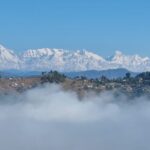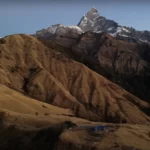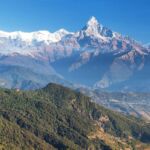Machhapuchhare, or Fishtail, is a mountain peak in Nepal‘s Annapurna Himalayas range. It is a prominent landmark and a popular destination for trekkers and hikers. The mountain is known for its unique fishtail-shaped summit, which is steep and sharp. At an elevation of 6,993 meters, Machhapuchhare is one of the most breathtaking mountains in the world.
Importance of Machhapuchhare for trekkers and hikers
Machhapuchhare, or Fishtail, is an important destination for trekkers and hikers visiting Nepal’s Annapurna Himalayas range. The mountain’s unique fishtail-shaped summit, breathtaking views, and challenging trails make it a popular choice for adventure seekers. Trekking in the region offers trekkers an opportunity to experience the local culture, traditions, and hospitality. Moreover, the picturesque scenery, diverse wildlife, and beautiful landscapes make Machhapuchhare a must-visit destination for nature lovers.
Location and Geography of Machhapuchhare
Location of Machhapuchhare in the Himalayas
Machhapuchhare is located in the Annapurna Himalayas range, a part of Nepal’s Himalayas. It is about 25 kilometres north of Pokhara in the Kaski district of Nepal. Other majestic mountains surround the peak, including Annapurna II, III, and IV. The region is known for its diverse flora and fauna, with several rare and endangered species. Machhapuchhare’s unique location in the heart of the Himalayas, surrounded by stunning landscapes and breathtaking views, makes it a must-visit destination for nature enthusiasts and adventure seekers alike.
Physical characteristics of Machhapuchhare

Machhapuchhare in the Himalayas is known for its unique physical characteristics that set it apart from other peaks in the Annapurna Himalayas range. The mountain’s fishtail-shaped summit, which rises steeply and sharply, is one of its most distinctive features. The summit is so steep that it has never been successfully climbed to the top. The mountain is also characterized by its rocky terrain, deep gorges, and narrow ridges. The region surrounding Machhapuchhare is rich in biodiversity, with several rare and endangered species of flora and fauna, making it a popular destination for nature lovers and adventure seekers.
Weather conditions in the Annapurna region
The weather conditions in the Annapurna region, including Machhapuchhare, can vary greatly depending on the season. The area experiences four distinct seasons: spring, summer, autumn, and winter.
- Spring (March to May) is the most popular trekking season in the region, as the weather is mild and dry. The temperatures are moderate, and the skies are clear, providing trekkers with spectacular views of the mountains and surrounding landscapes.
- Summer (June to August) is the monsoon season in Nepal, and the Annapurna region receives heavy rainfall during this time. Trekking during this season can be challenging, as the trails can be muddy and slippery, and landslides are at risk. However, the lush greenery and blooming flowers make the region look breathtakingly beautiful.
- Autumn (September to November) is another popular trekking season in the region. The weather is clear and dry, and the moderate temperatures make it an ideal time for trekking. The clear skies provide trekkers with stunning views of the mountains and surrounding landscapes.
- Winter (December to February) is the coldest season in the region. The temperatures can drop below freezing, and there is a risk of snowfall. Trekking during this season can be challenging, but the snow-covered landscapes and crystal-clear skies make it a magical experience.
Popular Trekking Routes and Trails
- Annapurna Circuit Trek
- Annapurna Base Camp Trek
- Khopra Danda Trek
- Mardi Himal
- Upper Mustang
- Ghorepani Poon Hill Trek
- Lamjung Himal
- Tilicho Lake
- Thorong La
- Jomsom Muktinath Trek
- Nar Phu Valley Trek
- Mustang
Accommodation and Facilities
Lodging options in the Annapurna trekking area
There are a variety of lodging options available in the Annapurna trekking area. Trekkers can choose to stay in teahouses, guesthouses, or lodges. These accommodations range from basic to more luxurious, and prices can vary depending on the level of comfort desired. Camping is also an option for those who prefer a more rugged experience. Trekkers have plenty of options, depending on their preferences and budget.
Availability of food and water
The availability of food and water in the Annapurna trekking area can vary depending on the location and season. Trekkers can find teahouses and lodges along the trails that offer meals and snacks. The food options may be limited but are usually nutritious and filling. The water sources can also vary, and trekkers are advised to carry a water purification system or buy bottled water to avoid getting sick. Staying hydrated while trekking in the region is essential, especially during summer when temperatures can rise.
Medical facilities and emergency services
The Annapurna trekking area’s medical facilities and emergency services are limited and basic. Trekkers are advised to carry their first aid kit and any necessary medication. In a medical emergency, the nearest medical facility is in Pokhara. However, the journey to Pokhara can take several hours and be challenging for a sick or injured person. Therefore, it is essential to take preventive measures to avoid getting sick or injured while trekking in the region.
Trekkers can seek help from the local authorities or rescue teams in an emergency. The Nepal Mountaineering Association (NMA) and the Trekking Agencies Association of Nepal (TAAN) have established rescue teams in the region to assist trekkers in case of emergency. These rescue teams can arrange a helicopter evacuation in case of severe illness or injury. However, a helicopter evacuation can be expensive, and trekkers must have adequate travel insurance covering emergency medical evacuation.
Moreover, hiring a licensed guide or porter who can assist in an emergency is essential. They are familiar with the trails and can provide first aid and help arrange medical assistance.
Summary
Machhapuchhare, or Fishtail, is a popular peak in Nepal’s Annapurna Himalayas. It offers unique views and a chance to experience local culture, diverse wildlife, and stunning landscapes. Adventurers are drawn to its rocky terrain, deep gorges, and narrow ridges. Spring and autumn are the favoured trekking seasons, and lodging options range from teahouses to guesthouses. Trekkers should prepare for varying food and water availability and limited medical facilities. Hiring a licensed guide or porter can be extremely helpful in case of any medical emergencies that occur during the trek.





Leave a Reply